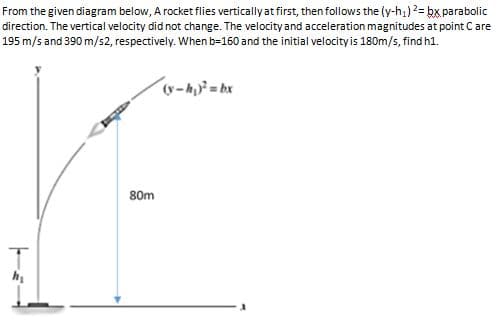From the given diagram below, A rocket flies vertically at first, then follows the (y-h;)?= bx parabolic direction. The vertical velocity did not change. The velocity and acceleration magnitudes at point C are 195 m/s and 390 m/s2, respectively. When b-160 and the initial velocityis 180m/s, find h1. (v-h = bx 80m
From the given diagram below, A rocket flies vertically at first, then follows the (y-h;)?= bx parabolic direction. The vertical velocity did not change. The velocity and acceleration magnitudes at point C are 195 m/s and 390 m/s2, respectively. When b-160 and the initial velocityis 180m/s, find h1. (v-h = bx 80m
Principles of Physics: A Calculus-Based Text
5th Edition
ISBN:9781133104261
Author:Raymond A. Serway, John W. Jewett
Publisher:Raymond A. Serway, John W. Jewett
Chapter3: Motion In Two Dimensions
Section: Chapter Questions
Problem 3P: A particle initially located at the origin has an acceleration of a=3.00jm/s2 and an initial...
Related questions
Question
100%
3
Kindly show complete solution for comparing to my answers. Thanks!

Transcribed Image Text:From the given diagram below, A rocket flies vertically at first, then follows the (y-h;)?= bx parabolic
direction. The vertical velocity did not change. The velocity and acceleration magnitudes at point C are
195 m/s and 390 m/s2, respectively. When b=160 and the initial velocityis 180m/s, find h1.
(v-h = bx
80m
ト-ミ
Expert Solution
This question has been solved!
Explore an expertly crafted, step-by-step solution for a thorough understanding of key concepts.
Step by step
Solved in 3 steps

Knowledge Booster
Learn more about
Need a deep-dive on the concept behind this application? Look no further. Learn more about this topic, physics and related others by exploring similar questions and additional content below.Recommended textbooks for you

Principles of Physics: A Calculus-Based Text
Physics
ISBN:
9781133104261
Author:
Raymond A. Serway, John W. Jewett
Publisher:
Cengage Learning

Principles of Physics: A Calculus-Based Text
Physics
ISBN:
9781133104261
Author:
Raymond A. Serway, John W. Jewett
Publisher:
Cengage Learning